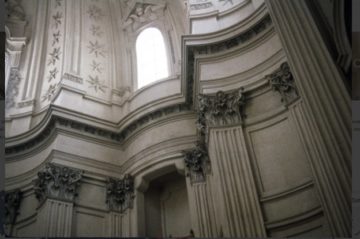Morgan Meis in The Easel:
 Morgan Meis: Borromini is a name probably not immediately familiar to your average reader. Can we start with a brief explanation of who he was and why his work is of interest?
Morgan Meis: Borromini is a name probably not immediately familiar to your average reader. Can we start with a brief explanation of who he was and why his work is of interest?
Jed Perl: Francesco Borromini is the mystery man of seventeenth-century Roman architecture. Both during his life and after his death – in 1667, possibly a suicide – this great architect was often overshadowed by another artist, Gian Lorenzo Bernini, who was not only a great architect but also a transcendent sculptor and a painter of consequence. Bernini’s Rome is all about grand gestures, crowds, spectacles — a place to see and be seen. He did much to shape the public face of Rome as we know it even today, through major commissions that included St. Peter’s in the Vatican and the Four Rivers Fountain in the Piazza Navona. Borromini brought other dimensions to seventeenth-century Rome – qualities of intimacy, fantasy, and interiority in buildings that include the churches of S. Carlo alle Quattro Fontane and S. Ivo della Sapienza and the Oratorio dei Filippini.
Deborah Rosenthal: Borromini, like all seventeenth-century Italian architects, used a classical vocabulary of columns, capitals, pediments, arches, and domes that dated back to ancient Greek and Roman times. But he took the stately and sometimes even static Euclidean geometry that those forms suggested to many great architects, and replaced it with a dancing, careening geometry of ovals and spirals and enigmatically torqued spaces.
More here.
